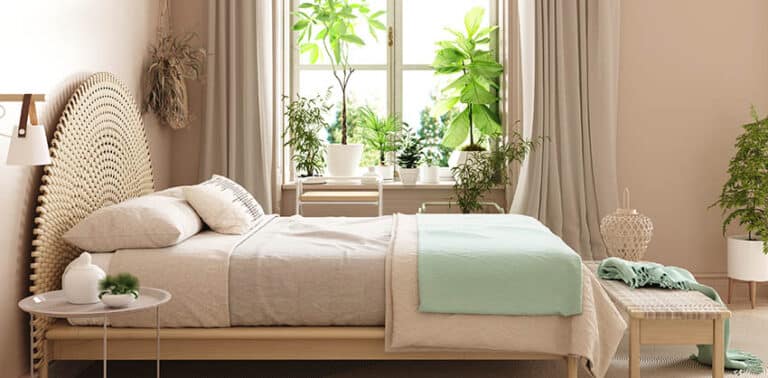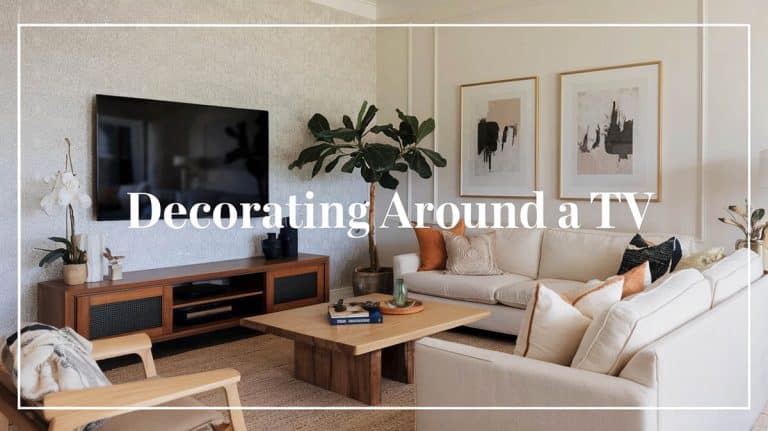Types Of Bamboo House Plants That Look Best

Bamboo house plants are a beautiful addition to any home and come with many benefits besides their aesthetic look. Bamboo is a common plant name related to more than a thousand types of flora. The many varieties represent plants from a full growth height of two feet to forest-sized trees at 100 feet tall. Of course, bamboo house plants need to be shorter, and some species grow anywhere from several feet to six or eight feet high that can be grown inside your home. This depends on the height of your ceilings where you want to keep the plants.
Shorter bamboo plants resemble grasses and, similar to tall plants, have hollow stems and thick roots, known as rhizomes. Mature stems of these plants are wood-like and often used for furniture, flooring, utensils, and numerous other products. The commonly sold Lucky Bamboo plant is not included in this guide. The Lucky plant is not actually a genuine type but is a tropical water lily plant called a Dracaena Sanderiana that resembles bamboo and grows best in water.
This guide contains information about which type of bamboo plant is better for inside your home, how to grow them and take care of them, the best place to place them, and how fast they grow.
Indoor Bamboo Plants
Several factors affect the type of indoor bamboo plant you choose to grow in your home. These tropical plants can tolerate being grown indoors but need extra care versus common houseplants, including particular light, temperature, location, soil, and moisture requirements.
Bamboo is very diverse and offers striking foliage for your living room, bedroom, kitchen, and essentially, most types of room in a house. They range from airy, tall species and shorter, more striking plants. The foliage may be a bold green color to pastel greens, and golden hues, and these tranquil plants add a touch of serenity to any décor.
They also provide a fresh look to modern interior design and an interesting and contrasting conversation piece for contemporary interiors. Growing bamboo as a house plant also provides a natural air filter for your home as it cleans the surrounding air and filters out toxins. These house plants are one of the best ways to purify the air in your home.
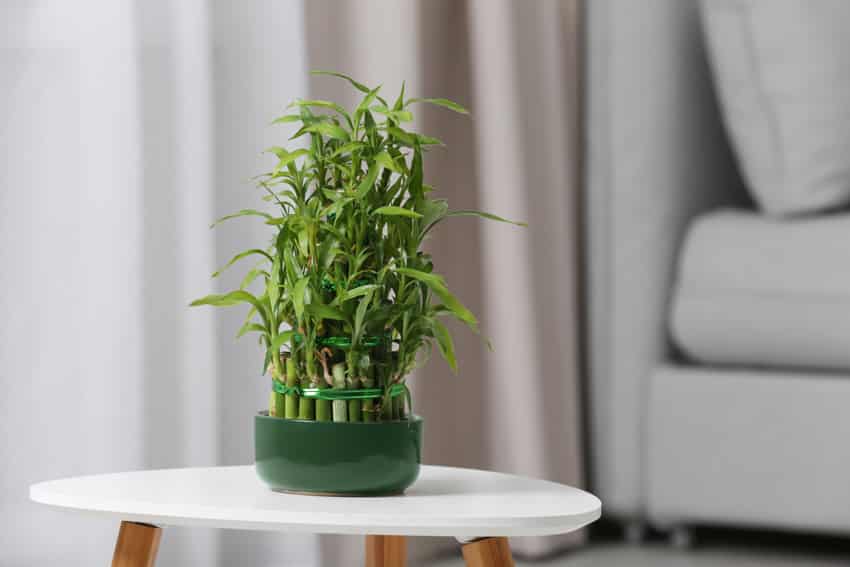
Which Bamboo Plant Is Best For Home?
When growing bamboo plants inside the home, some species choose that do better than others. If you’re concerned about height, the plants grown inside commonly grow only to a fraction of their natural height due to the different growing conditions versus growing outdoors.
This provides some flexibility in choices when considering height. Although these plants prefer to grow outdoors, the following are samples of good choices for growing in your home.
Buddha’s Belly, Bambusa Ventricosa
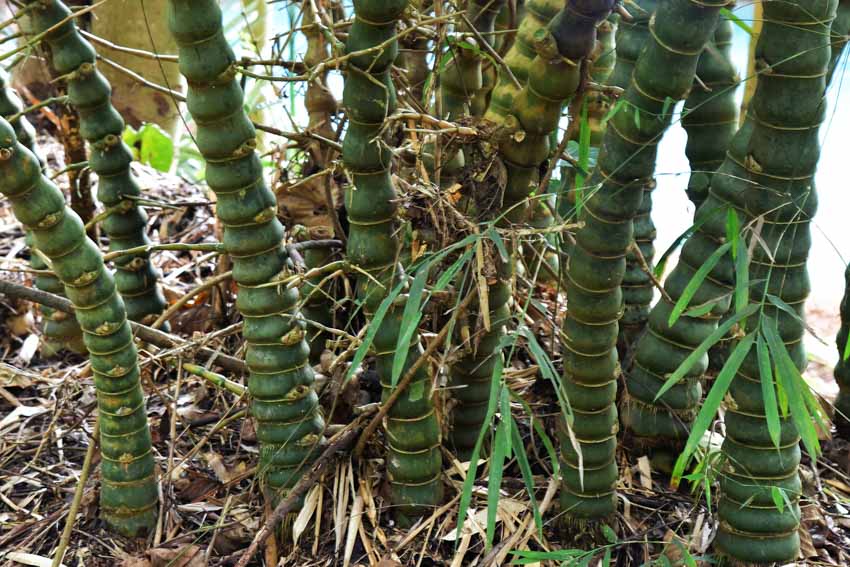
One of the easiest bamboo plants to grow indoors is the Buddha’s Belly, Bambusa Ventricosa, which grows from 5 to 15 feet high. A home with average height ceilings can accommodate their stalks with occasional pruning.
The stem called the culm, grows to a bloated size depending on the amount of water the plant receives. The less water a Buddha’s Belly plant receives, the more prominent the bulge around the culm, thus the name. This type is tolerant of indoor conditions and often used as a bonsai plant.
Giant Leaved Bamboo, Indocalamus Tessellatus
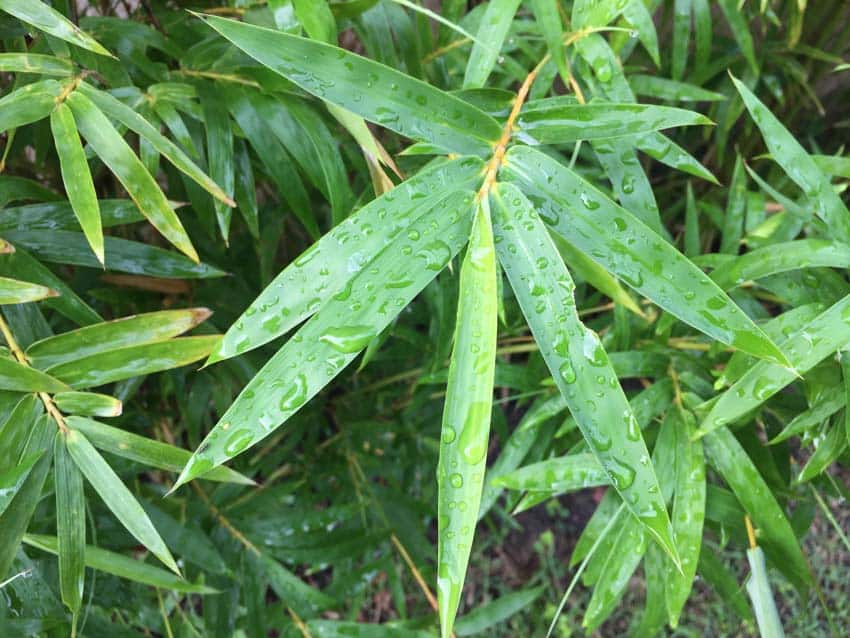
The Giant Leaved Bamboo is from China and has the largest leaves of all types grown in the United States. The leaves grow up to sometimes up to 2 feet long by 4 inches wide, and under normal conditions, the plant grows from 3 to 9 feet tall. Many cooks use the leaves to wrap foods for steaming, and florists like to use them in floral arrangements.
The Giant Leaved plant adapts to all growing conditions and can handle low light making it an excellent choice for an indoor potted plant. Growing it in a large container will cause it to form a dense thicket of stalks. See more low light houseplants on this page.
Black Bamboo, Phyllostachys Nigra
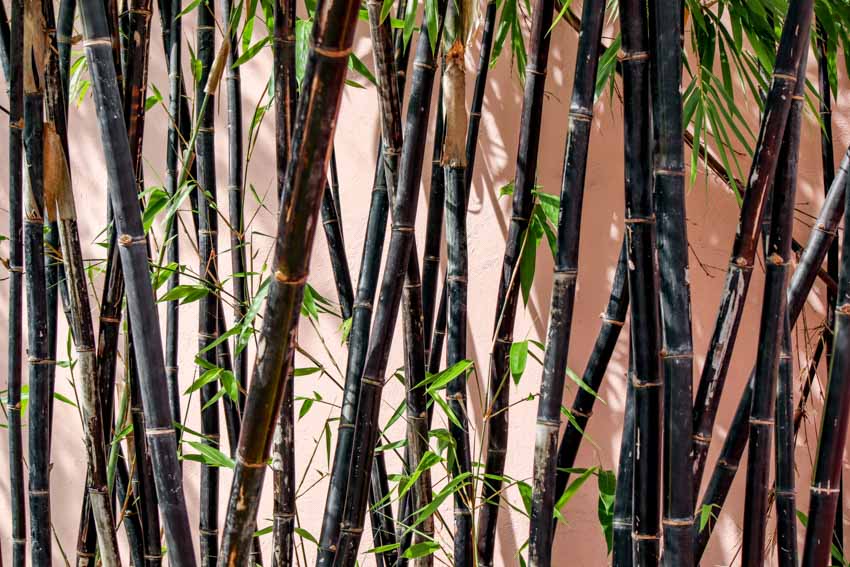
For an exciting and stunning conversation piece, the Black Bamboo is a beautiful plant that starts with lemony-green canes, which, after two years of direct sun, turn to a deep, ebony color.
The dark canes make a stark contrast against the green leaves creating a mysterious look. The Black Bamboo can grow up to 30 feet in the forest, but when grown potted inside, the plants commonly top out at 5 to 6 feet. This variety is also among the indoor plants that like direct sunlight and moist soil.
Bamboo House Plant Care
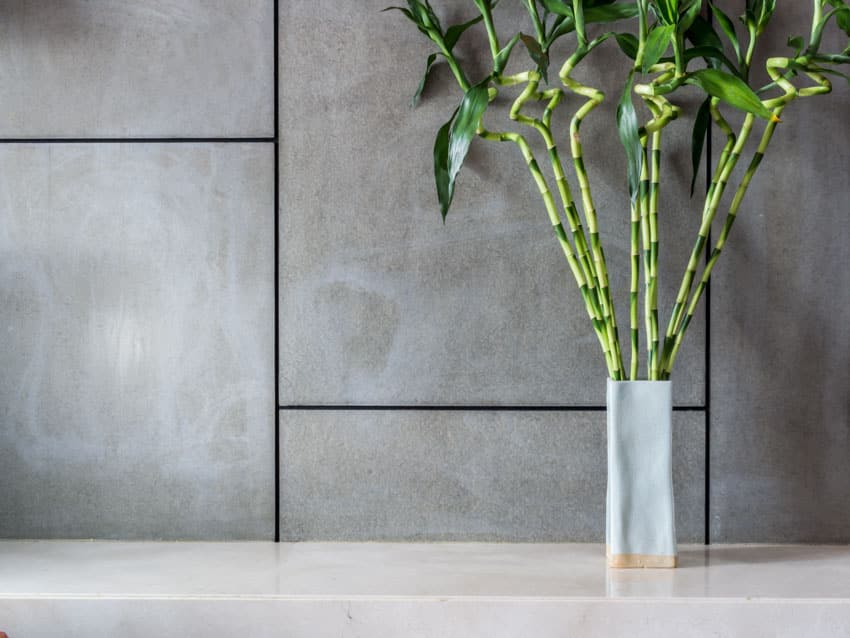
While certain bamboo species may require particular care, these plants do not need a lot of maintenance and grow well indoors with proper conditions.
Potting: Bamboo roots need a wider pot rather than a deeper planter and must have drainage holes on the bottom. Their roots like to spread, and a wide pot gives them room to stretch.
While Bamboo can tolerate many soil conditions, it’s best to use a mixture of 1/3 organic, rich potting soil, 1/3 peat moss, and 1/3 perlite, a planting additive made from heated volcanic glass.
Perlite appears as small Styrofoam balls and absorbs moisture to keep the soil moist but not wet. If you want a more straightforward solution, a high-quality all-in-one potting mix works fine as long as the roots have plenty of drainage. The perlite also helps the soil dry out quicker after watering to prevent root rot.
Another method that helps maintain proper moisture is placing a shallow layer of gravel in the bottom of the pot before adding the soil.
After it is planted, place the pot in a shallow saucer of water to allow water to absorb into the soil. If there is no gravel in the planter, the pot will have to be raised a bit to keep it out of water that collects in the saucer.
Pruning: Bamboo will look healthier if pruned on occasion. Browning leaves, older canes, and top-heavy leaves can be pruned on occasion but do not prune more than a handful of leaves and branches at one time.
New shoots coming up from the roots can be snipped off to prevent overcrowding and limit density. It’s advisable to prune the roots once a year by removing the plant from the pot to cut back the roots and divide the root ball.
• Lay a tarp on the floor in front of the plant and carefully lay the pot on its side, ensuring there is enough clearance for the plant to lay straight. Gently pull the plant and soil out of the pot onto the tarp.
With gloves on, remove the soil leaving it on the tarp until the roots are exposed. Using high-quality, sharp pruning shears, trim excess roots and divide the more extensive rhizomes.
Extra rhizome pieces can be placed in a shallow container of water held up by toothpicks to start a new plant. Once done pruning, slide the plant into the pot and add back the soil. Lift the pot and plant upright again and water with fertilizer to prevent shock.
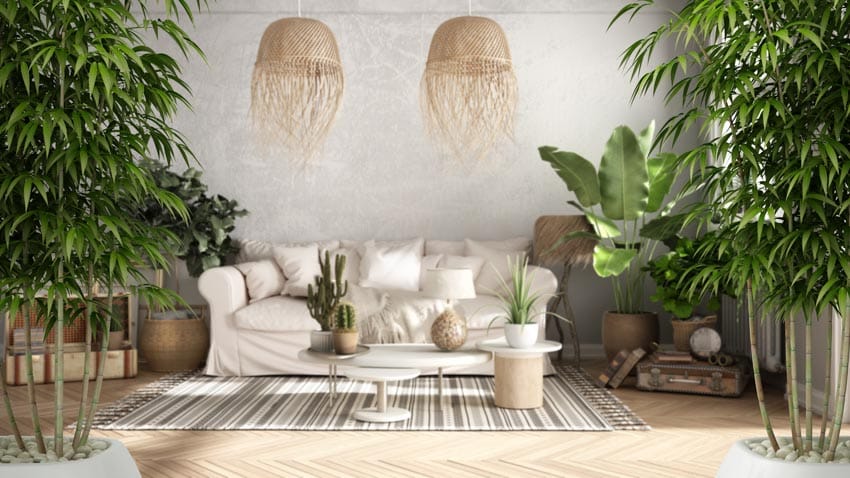
Watering: Bamboo needs to be watered more than once a week to keep the soil moist, but allowing it to dry out in between watering is a good practice to avoid root rot. Most of these indoor plants die from root damage from too much water and need soil that remains evenly moist.
To determine when to water, stick your finger two inches into the soil and water when it feels dry. The soil should stay a bit drier during the winter months as even indoor plants rest in the winter and require less water.
Plants are sensitive to chemicals commonly found in tap water. Leaving tap water overnight will help chlorine to dissipate, but it may still contain fluoride. Fluoride will cause the leaf tips to brown. When possible, use distilled or rainwater to water your plants.
Fertilizing: Bamboo is a nitrogen-hungry plant and needs regular fertilizing. Being planted in a pot, watering washes out nutrients from the soil.
Feed these houseplants a balanced liquid fertilizer once a month, or add a drop of liquid fertilizer each time you water to maintain a steady flow of nitrogen. A slow-release fertilizer rated at 14-14-14 with trace minerals is a good option.
The numbers on fertilizer containers represent the amounts of the primary nutrients. The first number is the amount of nitrogen, the second number is the amount of phosphorus, and the third number is potassium. All numbers represent percentages and are referred to as the fertilizer grade and are a national standard.
Bamboo Growing Conditions Indoors

One of the most important requirements for growing bamboo indoors is enough humidity. As discussed under Potting above, using a pebble tray is an excellent way to add moisture to the air around the plant. It’s essential to keep water in the saucer as it evaporates as these plants come from tropical climates and do not like the dry indoor air of a home, especially in the winter when the heat is on.
Use a spray bottle with filtered, distilled, or rainwater to mist the foliage a few times a week at the minimum, with every day being optimum. Using an indoor humidifier is also effective for adding moisture to indoor air. Bamboo may like moisture, but it does not want to be near heaters when grown indoors. It also prefers moving airflow to avoid stagnant air. A fan on a low setting is an easy way to duplicate the outdoor breezes these plants are accustomed to.
A few hours a week is all that’s needed. The airflow also helps to keep dust and small bugs off the plant. If the pot can be brought outside in good weather, it will appreciate the direct sunlight and can be lightly sprayed with a hose to clean the leaves.
Where To Place Bamboo Plant In The House
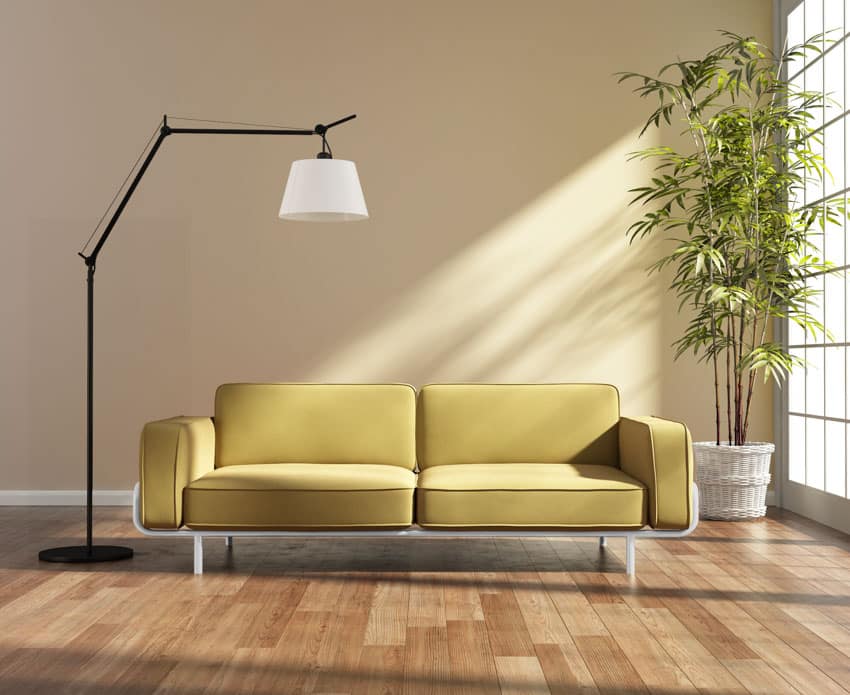
Part of rotating your indoor bamboo plant outside on occasion is to provide the direct sunlight that keeps it healthy. However, many plant species that are good candidates for growing indoors tolerate more shade. Most bamboo plants like to have six hours of sun per day. If your home has one of the enclosed types of sunroom with plenty of sunlight during the day, it will be the best place for the pot.
You can also place plants in a southern-facing window that provides the most amount of sunlight. Bamboo grown as a house plant will do just as well with indirect sunlight, growing slower than if the plant had ample sunshine. If you notice the plant losing leaves after planting it inside, give it some time.
Bamboo may drop its leaves to recuperate and grow new ones as it adjusts to its new environment. These plants do well with indoor temperatures between 62 and 78 degrees, the typical range in most homes and offices.
How Fast Does Bamboo Grow Indoors
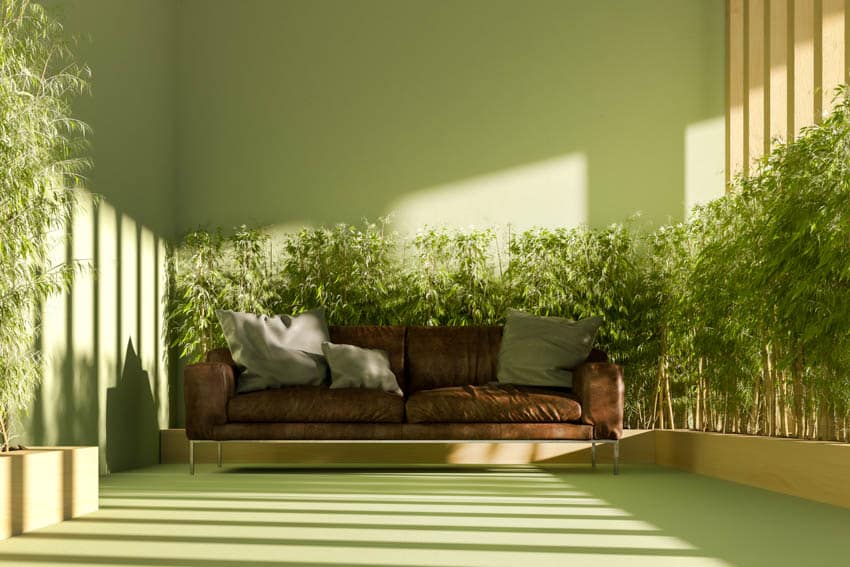
According to Guinness World Records, bamboo is the world’s fastest-growing plant on the planet. Certain species can grow as much as 35 inches a day, and the tallest recorded bamboo plant found in the tropics was 130 feet high. Of course, these statistics are for growing in its natural environment. Growing indoors presents a much different situation.
Each species grows at different rates and reaches varying heights. To estimate how fast bamboo grows indoors, find out how many feet the species grows per year. Divide this by 3 to estimate how fast the plant will grow in one year. At times, some types may grow to half its expected size when grown indoors.
Factors limiting how fast bamboo grows indoors include direct sunlight, watering, humidity, air temperature, and soil nutrients. The inhibited growth indoors makes it a good choice for growing in pots inside your home.
A Buddha’s Belly bamboo can grow from 50 to 80 in height at maturity. Yet, it may only grow from 3 to 10 feet in height total when grown indoors. Out of all houseplants, bamboo typically grows the fastest.

